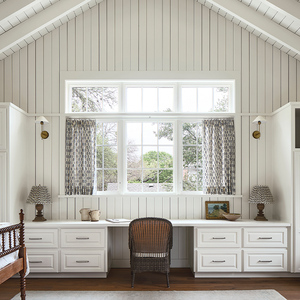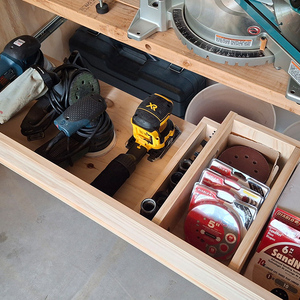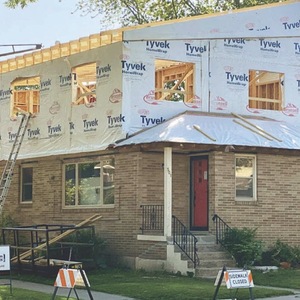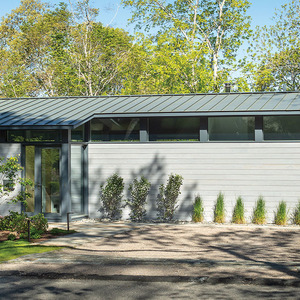If framing walls for speed was my goal, would it make sense to preconstruct the window and door openings as a section. Example: A 10ft wall would have cripple studs, header, jack and king studs. Put it together in your shop with a plate-king stud to king stud. Stack them in your shop- take them to the site and insert between top and bottom plate with the rest of the studs???I have a narrow time frame to work, but I could nickle and dime my way with sections
Go Cubs.
Dennis in Chicago



















Replies
If you had the right equipment, maybe.
I don't know your specific time constraints, but I would think spending the time to assemble in the shop then move the finished sections by hand would be time consuming. If you had a Lull type machine, moving the sections would be easier.
I think you would save the most time just by being organized. A good cut list coupled with your arrival at the site an hour early would save you alot of logistical issues.
BTW- where are you in Chicago? I also say go Cubs!
Jon Blakemore
Edited 4/18/2004 7:06 pm ET by Jon Blakemore
Edited 4/18/2004 7:06 pm ET by Jon Blakemore
If speed is the primary goal, I'd suggest just using organization and production techniques at the job site. We just started using production framing techniques last year and have seen a drastic increase in speed.
I just never realized how fast framing can go if you use the right methods!
Don't waste your time in the shop. Make a huge cut list and have a guy start cutting and nailing headers. Have him cut sills and jacks and anything else you can think of while your getting the firstfloor deck Laid. Stack it in a big pile for when it's wall time.
I'll be back after steak to give with lots more help.
thank you- you make alot of sense.
yep..what he said..
I worked with a builder in NC that did exactly what you described..he modified a toyota truck with a crane and drove it on the deck and stood up the pre made walls..PITA
and, the foundations were too far off from his prints to do a decent job..I quit after 4 days of his insanity..
View Image
Spheramid Enterprises Architectural Woodworks
Repairs, Remodeling, Restorations.
Another tip, if you already don't do it is to lay a 2x4 (assuming you're building a 2x4 wall) on top of the jacks and then the header on top of that.
MAkes the rocking go much smoother.
Be well
andy
My life is my passion!
http://CLIFFORDRENOVATIONS.COM
I think building stuff ahead in your shop could work well in some cases.
Like if you have a big rain on the day you're supposed to start framing. You could pull a couple of guys back into the shop and throw some stuff together.
Or maybe during the winter. You'd be more productive in the shop than outside if it's down to 10° or so.
Every job is different. Sometimes it might work well other times it wouldn't. Might be a good idea to try it once or twice and see what you think.
I got a great deal on a rhetorical phone. It never needs to be answered.
Your post is kinda what I was thinking. Its the nickle and dime time I'm trying to use. I could cut cripple studs on a radial arm saw really fast with a stop block screwed to the table (I got a 10' table to the side) for an example.
But then again would an hour at the woodshed tavern be a better use of my time??
"I made a my living 9 to 5 . .... I became a success from 5 to 9."
In the for what it's worth department, a couple of my larger framers have built plants in order to prebuild walls and such. Then they haul everything to the jobsite on flat bed trucks and using cranes and rough terrain telescopic forklifts (Lulls, Gehls, Ingersol Rand, Gradall, etc) put things up.. In the five years since they've started they have struggled to show a profit.!
The fastest method seems to be build with the use of a rough terrain forklift.. There is an honest 20% time savings while requiring the use of one to two less grunts..
The advantage comes from rapid acces to the reqired material.
For example, you pick up a whole stack of floor joists and as you extend the boom you set one down in place.. you've just saved 20 plus trips back and forth to the truss pile(OK TGI, joist, etc. pile) you then pick up a whole bunker of decking material (ha! I bet you thought I was gonna say plywood, didn't you?) as you extend the boom out you slide a sheet off the pile and drop it into place. Now you've saved 50 trips plus back and forth to the decking stack.. Plus nobody ever lifted a single sheet, (isn't it easier to slide and drop than lift and carry? ) Don't try this with a Lull, since some of them have only 500 pounds capacity at full extension. a bunker of 3/4 inch flooring weighs around 2000 pounds so ensure that the load chart is capable of the task you ask it to do..
You then pick up your wall studs and using the boom as a portable work stand saw them to length... (what you don't need for the first floor walls you set back) then you get your wall material and crry the whole bunker to your walls and put them in place..
You erect your walls using the forklift to keep the strain off your back. Then repeat for the second floor and at this point while many of the guys who buy my forklifts use the forklift to put the roof trusses into place.. In metro areas where you have access to a crane that is a mistake. It will often take you most of a day to do what a crane can do in an hour or so..
Next comes the plywood for the roof decking.. again pick up a whole bundle and extend the boom as you drop sheets in place.. when you get to the point where you are making a lot of cuts set the bundle down and put a workcage on . Cutting sheets of plywood goes much faster if you have a nice solid level platform to work off of and to act as your fall protection.
Once you are done with that part if you are doing the roofing work off of the platform again you'd be amazed at how much faster you can be with fall protection right there! (not to mention the ease of having the shingles right next to you so you never have to carry them!)
If not at least you can put the shingles/shakes/tile on the roof for the roofer.
Now it's time to install the windows, again use the workplatform to lift them up into place and securely hold them while someone levels and squares them.. what was often a day filled with strain and risk is a simple matter off of the workplatform..
Siding too goes up so nice off the workplatform.. Ingersol Rand evan sells a swing carriage that allows the forklift to work on narrow lots where ordinary forklifts can't get the platform square to the building..
In fact as long as you are working on the outside of the building a forklift is very handy!
Economics..
In general it's pretty hard to hire a grunt laborer for much less than $10.00 an hour evan in rural areas. add your costs to him and that guy costs you $15.00 easy. times 40 hours times 4 weeks and you are spending around $2400. for one guy..
here, forklifts rent for $1900.00 and when I rent them I apply 100% of the rent towards the purchase..
So you save $500 a month and build 20% faster.. (many use greater numbers but 20% is easy to prove) That means that you can build 20% more or go fishing 20% more often or some of each..
A typical framing crew evan for some of these really giant barns they call homes around here is three guys.. One who can read blueprints and organize things.. one who saws and cuts and nails and the third is a grunt..
Cutting sheets of plywood goes much faster if you have a nice solid level platform to work off of and to act as your fall protection.
Also, no fussing with overloading trusses on not-quite-nailed-off-yet roof members.
Some safety types might whine a bit about tying off to the head frame on the Lull. But you could point out that it is hard to find an OSHA-compliant tie off point 6' above the roof, even during construction.Occupational hazard of my occupation not being around (sorry Bubba)
Seems to me it would be nuts to tie off to a machine. Anyone could get in the thing and take off to get more plywood while you were tied to it. That would make for an interesting ride.
Or what if a hydraulic line broke while you were tied off to it?Women are like department Stores. Their clothes should always be half off.
they have this safety device called a key. you remove it when not in use.. I could go on but why belabor the point..
further, if a hydrulic line were to fail there is a flow restriction cartridge in all forklifts that restricts the rate which a boom is lowered..
Finally, you do not tie off to hydraulic lines! There is a safety rail on the workplatform for that purpose. it is rated for the required load and built for that purpose..
Just for information, In the past 13 years I have never seen anyone (except me) use the required safety harness and lanyard.. But still, the laws are there and they are for your protection..
Edited 4/19/2004 12:08 pm ET by frenchy
"they have this safety device called a key. you remove it when not in use.."
People aren't perfect, and not everyone is going to remove the key every time. And thr guy driving the lift isn't likely going to be the same one who's on the roof. So I think your point is invalid.
"if a hydrulic line were to fail there is a flow restriction cartridge in all forklifts that restricts the rate which a boom is lowered."
The boom would still drop down, with the guy(s) attached. Not a pretty picture. I doubt it would drop slowly enough that they could walk over and unhook everything. I don't want my life to depend on hydraulics.Diplomacy: After telling someone to go to hell, convincing them that they will enjoy the ride.
There are OSHA legal workplatforms (we sell them every day) that are perfectly legal to tie off on..
Ok,
Sorry it took me so long to get back. You know, dinner, kids who need baths, dog needs walking.
Anyway try a few of these tips.
1. Take the plan home and make an huge cut list. Headers, Jacks, Sills whatever else you can cut beforehand. When you start to lay Plywood across those joists, get a guy busy cutting. Have him keep it in a nice neat pile. Out of the way but close by. When I first started doing this I used to take a stud home and lay it on the Table so I could check My measurments.
2. When it comes time to stand up walls, heres the trick. The lead guys Set the plates up where they want them. they make sure they get the right headers, jacks and sills. The helpers nail it all together. that leaves the leads to get the next wall going. The order and location is big. You need to think about what wall next. How will this go up easier?
3. I'm not sure where your from? Do you guys Stick frame where everything is Toenailed? Or do you tilt-up. End Nail and maybe even put the sheething on before you stand them up? No matter some things I do the same no matter what. Build all of your wall plates at once. After I lay out I start building plates. If I'm gonna tilt-up I tack the bottom plate in place, then the first top plate over it. The second top plate I tack in place with Duplex nails. Then I lay everything out. All the studs, all the windows, everything I can. Joist lay out too. Don't forget toilets, plumbing and Partitions. I have seen some guys build one wall at a time starting with the plates. Doesn't make any sense to me. Why stop, cut plates, lay out, stand one wall, then do it all over again. My way I only lay-out once, and everthing is marked nice and clear.
If you are going to frame regularly you might want to try a few other tips.
4. If you don't already own one get a 10" saw. We make headers out of 2x10's. I always have the guys throw them up on a bench. Mark-out the whole length of 16' 2x10 for what will be cut out of it ( it sucks to pull nails back out and they ruion blades, 10" can be expensive.). Nail the two 2x10's together as well as a 2x4 bottom cap. then cut the whole thing with a 10" saw. Bunches faster.
5. Invest in a rugged Mitre saw and build a table with adjustable stops. 100 11 3/4" jacks will go much faster. Don't be fooled. It's for framing not trim. Don't waste money on a compound.
6. Scaffolding! I worked for a guy where everything we built for about two years had a 12' high or higher garage. No beam so the joists above were always 14" T.J.I. His son would always want to put them up with Ladders. I always built a scaffolding at each end. High enough for a guy to walk along and place the joist in place and nail it. Nothing fancy, just some 2x4's and planks. Two guys sliding them up on the scaffolding and two guys nailing. Cut the time in half. lots safer too. think about where a simple safe scaffolding will save you time. The few min's you need to set it up will pay you back ten fold most times.
7. A lift would be awsome. If the job is gonna be one month or more and you have the cashflow it will easily pay for itself. For smaller jobs think about a used roofers powerladder. with some practice you'll be surprised how much you can use it. Stuff like getting studs to the second floor, Ceiling beams, Rafters, you name it. We would often throw up a few Joists, Floor or ceiling, Sure them up, Spread a few sheets of plywood, and the rest of the floor or ceiling came up on the ladder. Just use your head. Think safety all the time. Never let the kids play Powerladder Rodeo.
8. Just like in the Army, Leaders meetings all the time. make sure you and your lead(s) get some face time. make sure you all have the same plan and everyone understands the days tasks and how you expect things to go. I*f you have a big crew, you should issue the orders and your leads should make sure they get carried out. If a helper is always asking you what to do, you need to talk to that lead, not the helper.
Well I hope at least on of these thimgs helps. My two weeks of screwing around is over and tomorrow it's back to work for real. Good luck. In my mind framing is the best part of a house. But ya gotta make it pay.
One objection to your idea of precutting all wood!
Too often the foundation is built wrong or not to specs.. maybe it's off a quarter of an inch here and a little bit there..
With precut wood you are forced into some ugly choices..
beside I object to that method because you are in fact double handleing wood! First to cut it (and stack it out of the way) and then to use it..
"Too often the foundation is built wrong or not to specs.. maybe it's off a quarter of an inch here and a little bit there.. "
You have to measure the foundation sooner or later and square it up anyway. So what difference does that make?
Besides, he's only talking about pre-building window and door components. The foundation doesn't matter with those.Everywhere I go, I'm asked if I think the universities stifle writers.My opinion is that they don't stifle enough of them. -- Flannery O'Connor
My objection to prebuilding anything is two fold.. one it requires double handling of the object/ material and two, it does not allow for slight adjustments based on how some things turn out..
We've all seen that there is a tolerance in materials.. perhaps a piece of high tolerance wood is right next to a low tolerance wood. That will cause a noticable step unless an adjustment is made.. Level plumb and true is great in a perfect world, however I've seen many a home look great just because the builder took a moment to make sure everything was eye sweet.
If you buy prefabbed rafters the sheet will give you the tolerance they are built to. often plus or minus a 1/4 of an inch.
If one is 1/4 inch long while the one next to it is a 1/4 inch short that 1/2 differance will make a noticble visual impact on the facia. Yet if the differance is split between the two it becomes nearly invisable..
Windows and doors need particular attention to level plumb and true while remaining eye sweet. He did mention sills and jambs. Since they have so much impact on things I feel it's better to cut them after things are up or measured. If I need to cheat an 1/8th to make things look good it's no big deal (unless I precut everything and I can't cheat it the needed amount..)
Note I never said Pre-Cut all wood. Just The Jacks, Sills, Headers and such.
In production framing the length of jacks, sills and headers will not be effected by a not perfect foundation. Other than that what else would you precut?
Better to cut it and stack it nearby than cut each piece as you use it. if you plan right, the cut guy is done right around the time you start to need the stuff. Then he can help put wals up.
I start to cut just as we start to lay the plywood for the floor. and only one floor at a time. Just what is gonna be needed.
If you start cutting jacks or sills to be perfect everytime you'll go broke.
Ok.
from that perspective that's fine except you still double handle wood. Often wall studs come in precut lengths (plus or minus the average error) and I'd rather have them that way. Eliminate cutting entirely if you can..
I kinda like to gang cut so I understand what you are talking about.. yet the time saved is really pretty small.. Around here because of insulation requirements we have a lot of 2x6's. With with a 16 inch saw you can gang cut on edge. Measure once, snap a line and bang they are all the correct length.. still you only save a few minutes..
Sure every few minutes add up but you need to be organized enough to capitalize on it.
we sledom use anything but precuts. the last time I cut studs for an entire house was when I lived in FLA. We even get 2x6 precuts. If you see guys cutting 2x6 studs they need to get with the salesman who's screwing them on the lumber package.
If you watch it in action, Jacks and sills get cut stacked and picked up for use. It's fast and painfully efficient. It also means I have a guy helping raise walls not cutting.
Ya could always try the gravity nailing technique , dont recommend it. I havent done it but I learned it from a old production framer who piece worked in the tracks here in the 70s.
Darkworksite4:
El americano pasado hacia fuera ase la bandera
ah ha..this is one of those threads that since the melt down..always stays up as unread..
the AIRHOSE thread was one too..now, after the hose thread was rekindled, and responded to..it no longer is listed as unread to me..so..here may be a FIX for us guys that have those nasties hanging on..
I hope someone else tries their "with unread messegages to me" boogers and see if it fixes it..
try it..someone respond to me and I'll see if it vanishes..thanks
Spheramid Enterprises Architectural Woodworks
Repairs, Remodeling, Restorations.
ok... here's your response ... did it do what you wanted ?Mike Smith Rhode Island : Design / Build / Repair / Restore
gonna find right out buddy..I'll let cha be knowin..thanx
Spheramid Enterprises Architectural Woodworks
Repairs, Remodeling, Restorations.
YES!!!
it worked! for the first time in months, it says 'no unread messages" yeee hawww..thanks
Spheramid Enterprises Architectural Woodworks
Repairs, Remodeling, Restorations.
You are a man with such simple pleasures.
and petty annoyances..prospero being one of them
Spheramid Enterprises Architectural Woodworks
Repairs, Remodeling, Restorations.